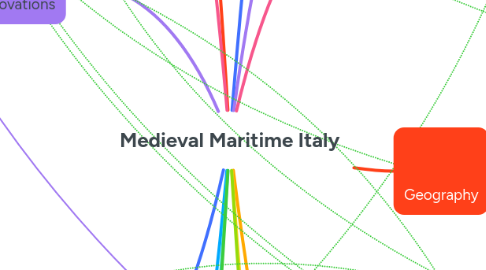
1. Rivalries & Conflicts
1.1. venice
1.1.1. Fourth Crusade
1.2. Capture of Almeria
1.3. Pisa
2. Religious Influence
2.1. Benedictines expanded city
2.2. Fled From Lombards
2.2.1. Religious artifacts brought with them
2.3. Baseline for founding cities
2.4. Merchants carry their faith with them
2.5. Venetian purpose of honoring God
2.6. Overall Roman Catholic traditions
2.7. Divine election
3. Technological Innovations
3.1. Dams
3.2. Printing Capital
3.3. Cisterns
3.4. "Imaginative Use"
3.5. Ships
3.5.1. Scythes and cylinders used for collecting salt
3.5.1.1. Quays
3.6. Hydrolic Projects
3.7. Reinforcing beaches
3.8. Teraferma of land
3.9. rafts
3.10. wooden caissons
3.10.1. Wood Procurement
3.11. Great sea walls, the murazzi
3.12. Machines in Grand Canal
4. Culture
4.1. Seafaring
4.2. Myth of Venice
4.3. architecture
4.3.1. palaces
4.3.2. churches
4.4. Art
4.4.1. Venetian Glass
5. Environmental
5.1. Lagoons
5.1.1. Sea levels
5.1.1.1. Dams or Divert
5.2. Silted Beds
5.3. Marshland
5.3.1. Draining Canals
5.3.2. Mud Packing
5.4. Disease
5.5. Destruction of Natural Habitat
5.6. Natural Defense/Mote
5.7. inhospitable marshes
5.8. grass
6. Other
7. Politics
8. Trade & Commerce
8.1. Salt Trade
8.2. Venice
8.2.1. Economy from the water
8.2.1.1. Canals and Channels
8.2.2. Byzantine Connection
8.2.3. Conflict with Genoa
8.2.3.1. 1256-1381
8.2.3.1.1. War of Chioggia
8.2.3.1.2. War of Curzola
8.2.3.1.3. War of Saint Sabas
8.3. Shipping
8.3.1. Christian Shipping
8.4. Shifting routes
8.5. spices
8.6. tariffs
9. Cultural Exchange
10. Economic Systems
10.1. Venice Mercantilism
10.2. Venice's Maritime Trade (Salt/Fish)
10.2.1. Venice's Trade with Mainland
10.3. Interior development projects (water rent)
10.3.1. Dredging Projects/Opening Inlets
10.4. Non-traditonal farming (used ships/cylinders)
11. Geography
11.1. Adriatic Sea
11.1.1. Aquatic Dominance
11.2. Ligurian Sea
11.3. Venice
11.3.1. Grand Canal
11.3.2. Lost Lagoons
11.3.3. Land Changing Shape
11.3.4. Original Islands
11.4. Gui-Decca
12. Major Port Cities
12.1. Genoa
12.1.1. Textiles, wine, luxury goods
12.1.2. Tied to Mediterranean Sea dominance
12.1.3. Po Valley connection
12.2. Venice
12.2.1. Luxury goods
12.2.2. Trade routes
12.2.3. Cross-cultural interactions
12.3. Amalfi
12.3.1. Connect to/trade with North Africa
12.3.2. Spices, timber, salt, fabrics
12.4. Pisa
12.4.1. Grain, salt and wool
12.4.2. Linens, cotton, salt
12.5. Naples
12.5.1. Oil, Silk, Wool
